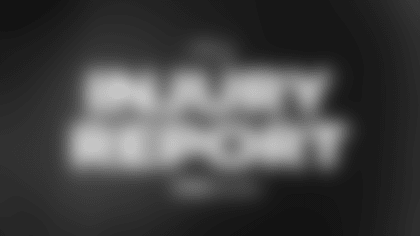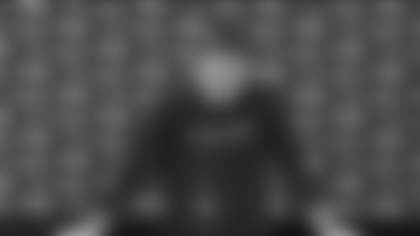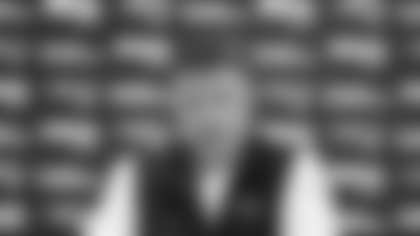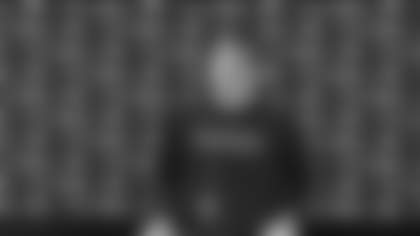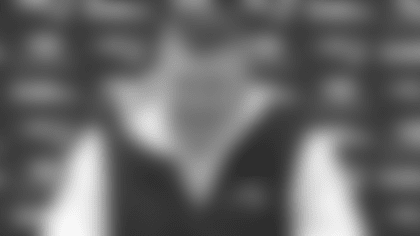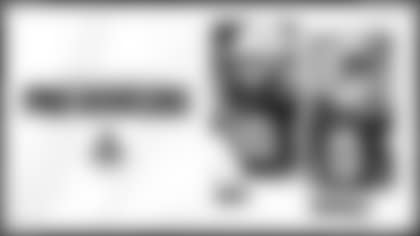BB: Alright, before we get into Cincinnati, just on behalf of the team we just want to send our - express our appreciation and support for the Boston Police Department. Kind of what they've been going through here the past couple of days, the injured officers, their families, just I can imagine - I can't imagine but I can imagine - the amount of stress that that department has to deal with and their challenges every day and the difficulty of the situation that they've been put in. I just want to let them know we're behind them, we appreciate them, we appreciate what they do for us and how they protect us and we're there for them. Relative to Cincinnati, again, this is a really good football team that's had great success over the last several years, winning [division] championships, winning divisions, winning a lot of games, playing really good football consistently. It'll be a big challenge for us this week in all three phases of the game to be able to compete with them and be able to play the level of football that it's going to take, playing and coaching, that it's going to take against Marvin [Lewis] and his staff and his team, so hopefully we have a good day today, clean up a few loose ends and kind of put the finishing touches on our preparation and be ready to go here Sunday afternoon. But it's a good football team. It's going to take good effort all the way around to be competitive. We know that.
Q: The fully padded practices seem to be coming a day later in the week than they normally do. What kind of benefit is there to the team in doing that?
BB: Yeah, each week we just try to do what we feel like is best for the team, and we move some periods around at practice. We don't always do everything the same as we did it the week before or whatever. It depends on what the needs of that week are, the emphasis points for the preparation and so forth, and pads or no pads is part of that discussion. So, it's really week-by-week.
Q: Does pushing the full-pad practice back to Thursday and make it a day further from the previous game help the players rest their bodies a bit or is that reading too much into it?
BB: No, I mean there are advantages to Wednesday. There are advantages to Thursday, right? Thursday gives them an extra day. It gives you a day to kind of get everything in and work on it to a degree and then execute it on Thursday a second time, if you will, maybe at a little bit better tempo or level of execution. Wednesday puts it a day further away from the game, a day closer to the previous game and a day further away from the upcoming game. If it's one or the other - when it's one or the other, which it is now obviously, I think you just try to get the most out of whichever one of those days it is. If it's do something in pads or not in pads and its more beneficial to do it in pads, then you try to find a way to schedule it there.
Q: How is David Andrews doing in the middle of your offensive line thus far?
BB: David's done a good job for us since he's come in here. He's been here a year and a half, a hard working guy, very smart, durable, dependable. He's done a good job for us.
Q: What are the challenges of the way Cincinnati runs their double A-gap blitzes?
BB: Right, yeah I think they give you a lot of looks with it. They get up there and come. They get up there and just bring one guy, they get up there and don't bring anybody, they get up there and bring guys from the edge. It forces you to commit your protection inside to them and then the guys come from the outside in. Yeah, they do a good job of that. They have a good package of it. We do a decent amount of it, too. I can't imagine that - we've practiced against it against our defense going back to the spring so we've seen probably as much of it as they've seen it from themselves. You still have to block it, they still have a good package off it, and they do a good job disguising it. But we've worked on it. It's a good package, but we just have to do a good job with it depending on what play or protection we have called. We just have to do a good job of executing. But it could be a number of different things. I think that's the hard part of it, is they're up there, they may be coming, they may not be coming. They may be up there to draw your attention to them so somebody else can come or they may be up there and their good blitzers - [Vontaze] Burfict, [Rey] Maualuga, Vincent Rey - those guys are all - [Karlos] Dansby - they're all [good]. They can get pressure and good matchup's and run gains and stuff like that. They do a good job of it.
Q: What type of development have you seen from D.J. Foster over these first six or so weeks of the regular season?
BB: Well, it's kind of a new position for D.J. from where he was last year at Arizona State where he was out of the backfield a lot. He's spent a lot of time as a running back so running back has a lot of different responsibilities in terms of blitz pickup, running routes out of the back field, running plays, reading blocks, so forth, relative to like speed sweeps and things like that. He has some natural instincts. He has done those things in the past. Certainly he has gotten better on a steady basis. He works hard. For his size he's got good playing strength, good toughness. He's a tough kid and he works hard at what we ask him to do. But there are definitely a lot of things that he has had to work on. He has worked on them. He has improved on them. He made the roster so he did enough to do that, but he still has a lot of room for growth. I think every day he gains experience back there and that helps him. Some things he sees he missed and gets them right the next time. He just hasn't seen everything yet. But he's gaining on it.
Q: You are carrying three wide receivers on the practice squad currently. Why the need for depth at that position over another position?
BB: Most teams in the league are carrying six [wide receivers] on their roster. We're carrying five. One of those is obviously our core special teams player in [Matthew] Slater, so like most positions the more guys you have on the roster, the fewer guys you have on the practice squad. The fewer guys you have on the roster, the more guys you have on the practice squad. It's the same thing with the offensive line. The transaction we made last week, we were down to eight offensive linemen. That's probably the lowest in the league so we have more practice squad players on the offensive line because we have fewer players on the active roster.
Q: With the uncertainty of his availability on Sunday, how much can you game plan for a guy like Tyler Eifert?
BB: We game plan for everybody on the roster until we know for sure that they're out. Whether that's - however that information becomes available. Obviously, it's never final until the roster is turned in an hour and a half before the game, the inactives are declared, but up until we feel a player is out of the game then we prepare for them. We do that with everybody every week. There are always a number of guys that are in that, whatever range you want to call it, but until they're out then we prepare for them.
Q: What do you see from a guy like Eifert and does it make it a little bit easier to go against him since you see some pretty good tight ends weekly on your own roster?
BB: Well, I wouldn't put it that way. Look, each player has their own individual skill set and I think he's a good player. I think Eifert's a very good player. I wouldn't say he is identical to players we have on our roster. Again, that doesn't make him bad or good, or make us bad or good or anything. It's just different. So, matching up the different skill sets of players is part of the challenge this week or in this league every week. All teams have good players but not all players are the same. You have to find different ways of matching up to each guy depending on what your individual skill set is or as a coach what skills your players have relative to what skills they have. So, that's the challenge. He's a good player and he does a lot for their offense. I mean he can affect the deep, short and intermediate levels of the defense. He's a solid blocker, he's a big target, he's good after the catch so he creates a lot of problems.
Q: Earlier this week you were shown on Patriots.com breaking down film with Scott Zolak. You were discussing on kickoff coverage why the unit was sort of bunched together. Could you elaborate a little bit on that and what kind of challenge that presents to the opponent?
BB: Well, again, there's a lot of different ways to do things and there's no, I would say, right or wrong way. When you put a lot of players together it's less defined for the return team who's where. Who is the five? Who is the four? Who is the three? Who's the safety? And also possibly sometimes those alignments of players play into the direction of the kick. Some teams have a kick side, five guys on the kick side, five guys on the backside, so again, depending on how those players are distributed may give keys to the return team ahead of time. If you just line up straight across - 'Here we are. Come and get us or we're coming to get you,' - that certainly takes some of the mystery out of who's where. It's easy to sit back there and identify 'I've got the three. You've got the four.' Who's playing the five? Is it a speed player? Is it a size player? Who is it? So, the movement can disguise that a little bit. We see that from a lot of teams in the league. We do it some, we don't always do it. There are some advantages on the kickoff team, again, to just lining up and 'OK, we know where they are,' and get a good read on our keys. We see where their players are lined up and where they go when the ball is kicked and we react to them, or we can be on the move and maybe make it a little cloudy for the other side but maybe it's not quite as defined for us either. Again, there are advantages to doing it both ways. And we do it and I would say there are a lot of teams in the league that it might be more of one than another, but I'd say most teams have some element of both. I think there's a place for different alignments on the kickoff team.
Q: Do you look at some of the struggles on defense in the red-area as a concern or is simply too small of a sample size?
BB: We're a third of the way through the season, so I mean look, we try to improve on everything every week. That's where we are. We're in September to early October. Nothing probably is as good as it's going to be, at least I hope not, as good as it's going to be over the course of the year. Hopefully we'll continue to improve in every area; running the ball, throwing the ball, defending the run, defending the pass, situational football, special teams. I mean you name it. There are a lot of things we need to work on. We all have things we need to do better, coach better, improve on and everything's in that category. Statistically some things are better than others but regardless I think we try to continue to improve in all of those areas. It doesn't really matter what the stats are or aren't. I mean it matters; they're somewhat relevant. But I think improving in every area is important, so yeah, we're going to address it regardless in everything.
Q: What changes for a defense inside the twenty-yard line?
BB: Less field. Offensively everybody's closer to the line so the safeties are linebackers; linebackers are in a lot of cases borderline defensive lineman. Everything's just compressed. So, there are a lot of things you have to handle differently. Routes are different, coverages are different.
Q: Do the physical matchups become underscored when there is less field like that in the red zone?
BB: They could; they could, yeah. It depends, again, on the matchup but generally you see more size in that area because there's less space so speed is less of a factor. It's always a factor but less of a factor. There's only so far you can run. Technique is important, coordination offensively or defensively is important, the proper spacing, the proper leverage, using the space that you have and of course everything happens so much quicker down there because there's less space and less time so throws and catches have to be good, a lot of tight coverage, a lot of catches away from the body into a short space. Defensively you're fighting for every inch, every yard. It's critical. Two yards at midfield is one thing. Two yards on the five-yard line is 50 percent of the length; 50 percent of the field. So, it's all heightened, it's all a little bit more urgent and there are definitely some personnel and scheme factors that - there's a transition period in there but once you get down there low like inside the 10-yard line or inside the five-yard line you're talking about real tight space.





















